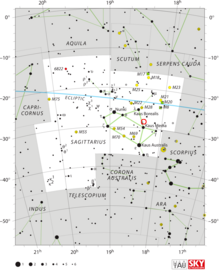Our website is made possible by displaying online advertisements to our visitors.
Please consider supporting us by disabling your ad blocker.
V5856 Sagittarii
| Observation data Epoch J2000 Equinox J2000 | |
|---|---|
| Constellation | Sagittarius |
| Right ascension | 18h 20m 52.25s[1] |
| Declination | −28° 22′ 12.1″[1] |
| Apparent magnitude (V) | 5.4 – <22[2] |
| Characteristics | |
| Variable type | Nova[3] |
| Astrometry | |
| Distance | 4200+1200 −900[4] pc |
| Other designations | |
| Database references | |
| SIMBAD | data |

V5856 Sagittarii, also known as Nova Sagittarii 2016 Number 4, was the 4th and brightest nova that occurred in the constellation Sagittarius during 2016. It was discovered by the All Sky Automated Survey for SuperNovae (which assigned to it the name ASASSN-16ma) on 25.02 October 2016, at which time it had an apparent visual magnitude of 13.7.[7] It was independently discovered by Yukio Sakurai of Mito, Ibaraki, Japan on 26.38 October 2016, by which time it had reached magnitude 10.4.[8] It reached its peak brightness of magnitude 5.4, making it visible to the naked eye, on 8 November 2016.[4] The nova occurred within a region of the sky monitored by the OGLE microlensing experiment, and that group reported that no star brighter than magnitude 22 (I band) was seen at the nova's position prior to its eruption.[1]
V5856 Sagittarii declined from peak brightness rapidly, fading by 2 magnitudes in 11.3 days, and 3 magnitudes in 14.5 days.[9] It is therefore classified as a "fast" nova in the classification scheme of Cecilia Payne-Gaposchkin.[10] The nova showed two peaks: a "fireball" peak corresponding to the freely expanding material ejected from the eruption and, nearly a week later, a second brighter peak coincident in time with the detection of γ-rays from the nova by Fermi-LAT. The fireball peak occurred at different times depending upon the wavelength of light being observed, but the second peak occurred at the same time for all wavelengths.[11]

All novae are binary stars, with a "donor" star orbiting a white dwarf. The two stars are so close to each other that matter is transferred from the donor to the white dwarf. In the case of V5856 Sagittarii, the absence of a detection of a progenitor in the OGLE images suggests that the donor is a dwarf star.[11]
- ^ a b c Cite error: The named reference
mrozwas invoked but never defined (see the help page). - ^ Cite error: The named reference
aav1was invoked but never defined (see the help page). - ^ Cite error: The named reference
ate1was invoked but never defined (see the help page). - ^ a b Cite error: The named reference
liwas invoked but never defined (see the help page). - ^ Cite error: The named reference
SIMBADwas invoked but never defined (see the help page). - ^ Cite error: The named reference
kojiwas invoked but never defined (see the help page). - ^ Cite error: The named reference
atel9669was invoked but never defined (see the help page). - ^ Cite error: The named reference
IAU9286was invoked but never defined (see the help page). - ^ Cite error: The named reference
ozdowas invoked but never defined (see the help page). - ^ Cite error: The named reference
paynwas invoked but never defined (see the help page). - ^ a b Cite error: The named reference
munawas invoked but never defined (see the help page).
Previous Page Next Page



